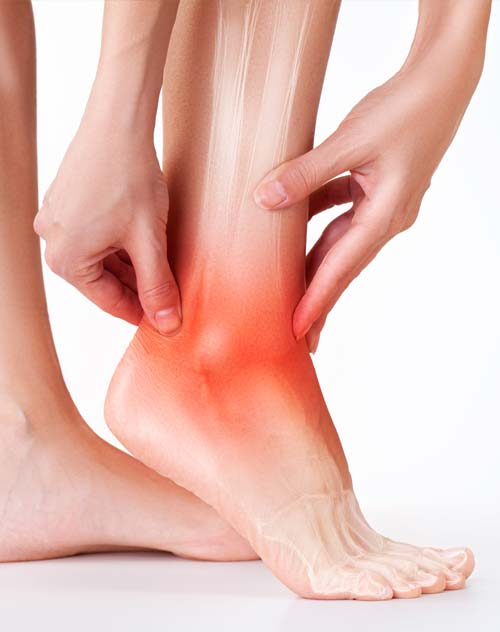Foot & Ankle
Conditions
Foot & Ankle
Let’s take a look at some of the more common foot and ankle conditions that Regen Doctor can treat with PRP and stem cells.
Conditions We Treat
At the back of the ankle, you will find the Achilles tendon. This connects the lower calf muscles to the heel, allowing for a full range of upright movements. If tendinosis appears here, tiny tears start to develop and the tendon thickens. Significant pain and discomfort may ensue. The condition can become chronic and progressive. Causes include overuse and sudden injuries. It is most common in those over the age of 50, although it can appear in younger people as well. PRP and/or stem cell treatments can lead to a full recovery.
- Osteoarthritis of the Foot and Ankle (Although osteoarthritis of the foot and ankle is not very common, it does occur)
- Post-Traumatic Ankle Arthritis
- Post-Traumatic Foot Arthritis
This condition is incredibly painful and occurs in the two peroneal tendons of the ankle. Usually, the condition is caused by overuse, which makes the tendons rub against the bone of the leg. This leads to tendonitis, which then further increases the thickness of the tendon, creating a vicious cycle of pain. The disorder, therefore, is usually progressive and can often not be attributed to a specific injury. It is also often misdiagnosed, meaning people don’t get the right treatment. Symptoms include swelling, pain, warm skin, an increase in the height of the foot arch and loss of strength.
The arch tendon of the foot is known as the plantar fascia. If this is overused, plantar fasciitis can occur. This often presents as stabbing pain, particularly during walking. As the foot warms up, the pain tends to dissipate. It is a particularly common condition amongst athletes, who overuse their feet for prolonged periods of time, as well as having high impacts on the area. This then makes the tendon thicken up, which causes inflammation, in turn making it swell up even more and so on.
Treatment usually involves wearing an orthopedic foot support and physiotherapy. Steroid injections may also be recommended. At times, these types of treatment are effective, other times, they are not. If the treatment is not successful, surgery is generally the only option. However, there is a significant risk that surgery won’t help and that it may even make matters worse. This is why stem cell or PRP treatment may be a better option, similar or better results with less risk and less recovery time.
This condition affects the nerves that can be found in between the toes. Fibrous tissue starts to develop around the nerves themselves, compressing and irritating them. People who suffer from this condition tend to experience severe pain around their foot’s ball, as well as around the base of their toes. The condition can affect just one foot or both and it is most common to find the nerve between the 3rd and 4th toe to be affected. However, it can affect other toes as well. It is not known why some people seem to develop this condition, although it is believed to be associated with other foot problems such as:
- bunions
- high arches
- hammer toes
- flat feet
Treatment generally involves taking pain medication and wearing special shoes with a wide toe area. If none of these options are effective, most people will be prescribed steroid injections, which have various negative side effects. Finally, surgery can be used to remove the parts of the nerves that have thickened. This is a risky procedure as nerve damage can occur and make matters worse.. To avoid all of this, you may want to consider stem cell or PRP treatment instead. This simply allows your body to regenerate healthy tissue by using the cells found in your own body.
This syndrome occurs when the posterior tibial nerve becomes compressed. This nerve is found in the foot, which means that the condition can be very difficult to live with, as it can significantly reduce mobility. It is a rare condition, but those who do have it have stated that it is very life-limiting, because even the sensory nerves found in the ankle and the syndrome can alter foot. The condition is most common in healthy, active adults, although some children develop it too. It is often linked to (post-traumatic) osteoarthritis, and many people who have it also have ganglion cysts or other growths on their body.
Treatment usually starts with orthotics, fascial stripping, and manipulation. People tend to have to wear custom-made shoes with added width. NSAIDs (non-steroidal anti-inflammatory drugs) may also be recommended. If this does not work, then steroids are recommended. The final option is surgery, where decompression is performed. It has to be done early, however, or the nerve will go into fibrosis. The alternative of stem cell and PRP treatment sounds much more pleasant.
Clearly, it is possible to receive treatment for various foot and ankle conditions without having to turn to surgery or steroid injections. Contact the Regenerative Medicine Specialists today and see what the experts can do for you.
Schedule your free consultation today!
Call us today
or

